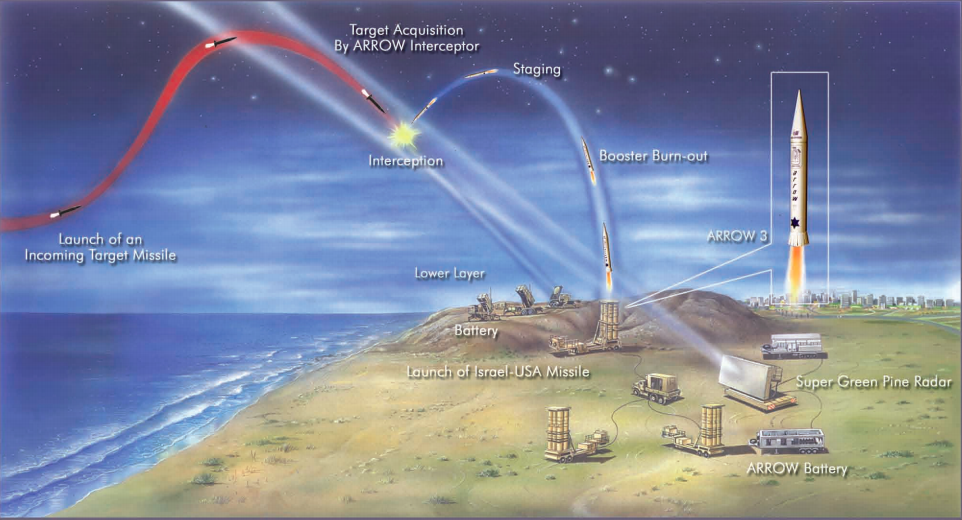TEL AVIV: Complex export rules make it much easier to sell a high-tech weapons system labeled “Made In The USA” than one marked “Made In Israel.” So it’s significant that last week, the US subsidiary of Israel Aerospace Industries (IAI), Mississippi-based Stark Aerospace, ceremoniously delivered the first US-built canister for IAI’s Arrow-3 missile defense interceptor.
While IAI and Stark, and Boeing – also deeply involved in the Arrow – didn’t point this out publicly, a source close to the Arrow program told me that producing such key components in the US could make it possible to export the system worldwide.
Arie Herzog, former head of Israel’s missile defense directorate, agreed: “The transfer of production of the system’s components to the US will, without any doubt, make it easier to offer the Arrow to the countries that want it. This will be a complicated process, but a door was certainly opened last week.”

US and Israeli dignitaries celebrate the first Arrow-3 missile canister delivered by IAI’s US subsidiary, Mississippi-based Stark Aerospace.
Japan, South Korea, and other countries have already shown great interest in the Arrow system. But US involvement in this program prevented even preliminary discussions about an export deal. Why? Because when the US helps fund development of an Israeli weapons system, it gets a veto over any exports of that system – a veto which Washington uses to prevent Israeli competition with US products in the global market.
What’s more, the US is imposing new restrictions on its defense grants to Israel, which Tel Aviv traditionally converts in large part from US dollars to Israeli shekels so it can pay Israeli companies. The new rules steadily reduce the amount of aid Israel can convert this way, ultimately cutting it to zero – which means all the aid has to be spent in dollars. That will affect $500 million a year in US Foreign Military Funding (FMF) grants for Israeli missile defense programs alone.
So IAI, like many other Israeli companies, is reacting by turning to US affiliates, subcontractors, and partners. And spending the money back in the US not only helps IAI comply with the new rules, it builds a domestic US constituency for the program. Attending last week’s delivery ceremony at Stark, along with officials of the Israeli Ministry of Defense, were Mississippi Governor Phil Bryant and several members of Mississippi’s congressional delegation.
IAI, Arrow, & Boeing
IAI is the prime contractor for the Arrow Weapons System, the upper tier of Israel’s multi-layered missile defense. Arrow defends against ballistic missiles; David’s Sling is the middle tier, defending against cruise missiles, some ballistic missiles, and larger rockets; and the famed Iron Dome is the lower tier, defending against relatively short-ranged artillery rockets. Indeed, Israeli proudly call this combination the world’s first truly national missile defense system, noting that America’s Ground-Based Midcourse Defense (GMD) doesn’t cover the entire US.
ississippi’s Stark builds the canister for the Arrow-3, which engages incoming missiles at very long range and very high altitude, outside the atmosphere. IAI also builds the complementary Arrow-2, an earlier model that takes on lower-altitude threats.
Boeing has been deeply involved in the Arrow program for years, providing components for the Arrow-2 and co-developing and co-producing the Arrow-3.
In 2014, Boeing missile experts were present in the IAF’s Palmachim airbase, where the second successful flight test of the Arrow-3 missile was conducted jointly by the Israel Ministry of Defense and the US Missile Defense Agency. The system passed its first full interception test over the Mediterranean sea in 2015 and was deployed in Israel in 2017.
A live intercept test in Alaska was planned for 2018, but it was postponed “to improve the system’s readiness,” the Israeli Defense Ministry said. No new date was given. But sources told me that the Alaska test is still in the works, and it will evaluate some significant advancements to the Arrow-3 to better defend against “new, evolving” threats.
Navy jet trainer fleet operations remain paused after engine mishap
One week after the incident, a Navy spokesperson says the service is continuing to assess the fleet’s ability to safely resume flight.



























